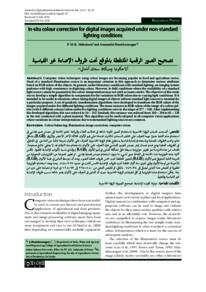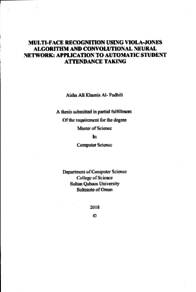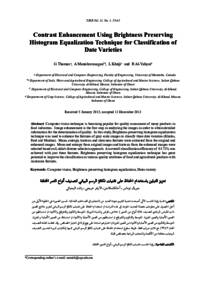وثيقة
In-situ colour correction for digital images acquired under non-standard lighting conditions.
المساهمون
الناشر
جامعة السلطان قابوس. كلية العلوم الزراعية والبحرية
ميلادي
2017
اللغة
الأنجليزية
الملخص الإنجليزي
Computer vision techniques using colour images are becoming popular in food and agriculture sector. Need of a standard illumination source is an important criterion in this approach to determine various attributes based on RGB values of the objects. In general, under laboratory conditions with standard lighting, an imaging system performs with high consistency in digitizing colour. However, in field conditions where the availability of a standard light source cannot be guaranteed, the colour interpretations may not yield accurate results. The objective of this study was to develop a simple algorithm to compensate for the variations in RGB values due to varying light conditions. It is intended to be useful in situations where taking digital images of objects without standard light sources is essential for a particular purpose. A set of quadratic transformation algorithms were developed to transform the RGB values of the images acquired under five different lighting conditions. The mean variance in RGB values of the image of a colour palette) with 6 different colours) taken under five lighting conditions were in the range of 277 – 548. After implementing the developed algorithm, this was reduced to 34 – 142. Similarly, this variance was reduced from 180 – 294 to 63 – 128 in the test conducted with a plant material. This algorithm can be easily adopted in all computer vision applications where variations in colour interpretations due to nonstandard lighting sources are common.
المجموعة
ISSN
2410-1079
URL المصدر
zcustom_txt_2
Alahakoon, P. M. K., & Manickavasagan, A. (2017). In-situ colour correction for digital images acquired under non-standard lighting conditions. Agricultural and Marian Sciences Journal, 22 (1), 42-47.
الملخص العربي
أصبحت تقنيات الرؤية الحاسوبية باستخدام الصور الملونة شائعة في مجالات الغذاء والزراعة. تعتبر الحاجة إلى مصدر ضوء قياسي في استخدام هذه التقنية معيارا مهما للتعرف على مختلف السمات للأشياء اعتمادا على قيم الألوان الثلاثة الأحمر الأخضر والأزرق (RGB) بشكل عام، وتحت الظروف المعملية وباستخدام إضاءة قياسية يستطيع نظام الرؤية الحاسوبية التعرف على الألوان بدرجة عالية من التناسق. في المقابل، في الظروف الفعلية ومع عدم ضمان توفر مصدر للضوء القياسي فإن التعرف على الألوان باستخدام هذا النظام قد لا يعطي نتائج صحيحة. الهدف من هذه الدراسة هو تطوير خوارزمية بسيطة لحل مشكلة التباين في قيم الألوان (RGB) والذي تسببه تأثرات الإضاءة المتغيرة. تكمن أهمية هذه الخوارزمية عند الحاجة إلى التقاط صور لشيء ما بدون استخدام مصدر إضاءة قياسي. تم تطوير مجموعة من الخوارزميات التحويلية من الدرجة الثانية لتحويل قيم الألوان (RGB) للصور الملتقطة تحت خمس ظروف مختلفة للضوء. وجد أن متوسط التباين في قيمة الألوان (RGB) المأخوذة عن لوحة الألوان والتي تحوي ستة ألوان مختلفة تحت ظروف الإضاءة الخمس كانت في حدود 277 -548. بينما وبعد استخدام الخوارزمية المطورة تم تخفيض هذا التباين ليصل إلى 34- 142. بالمثل، تم تقليص التباين من 180- 294 إلى 63- 128 في تجربة تم تنفيذها على جزء من نبتة. يمكن استخدام هذه الخوارزمية في كل تطبيقات الرؤية الحاسوبية حيث أن التباين في التعرف على الألوان يعتبر شائعا بسبب ظروف الإضاءة غير القياسية والمتغيرة.
قالب العنصر
مقالات الدوريات



